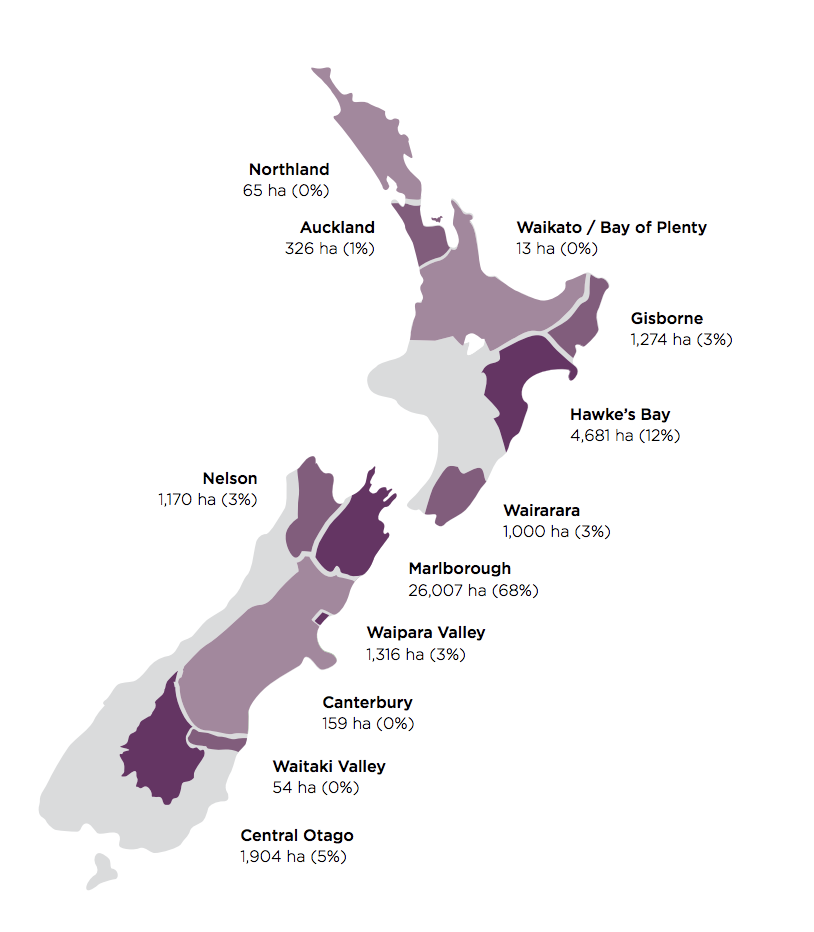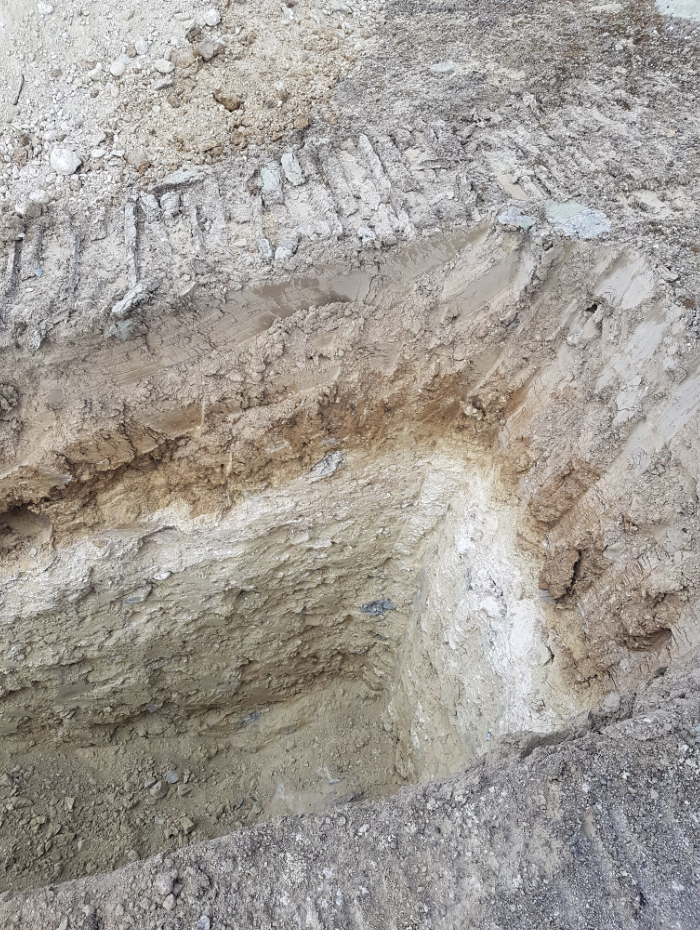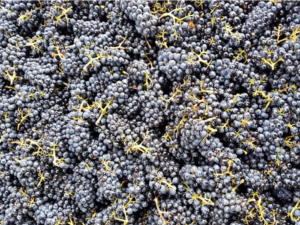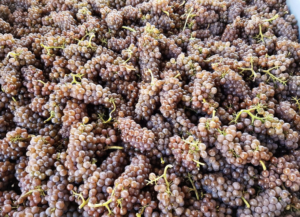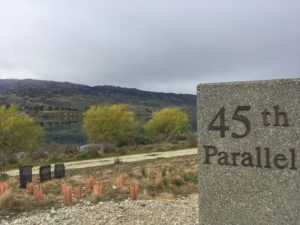
Central Otago is not only the southernmost wine region in New Zealand, but it is also the southernmost commercial wine region in the world. At a latitude of 45° south, the only other vineyards that compete are experimental plantings in South America’s Patagonia. The southerly position of Central Otago is key to the wine’s identity but so are its continentality, soils and winemakers. Explore the terroir essentials of the world’s southernmost wine region with us in this Central Otago wine region guide.
Where is Central Otago?

NZwine.com
Central Otago is inland, in the southern central region of New Zealand’s South Island (Te Wai Pounamu), approximately 1000km from Auckland. The closest major city is Queenstown, although the Central Otago wine region extends towards the north of Queenstown.
The sub-regions of the Central Otago wine region effectively form a triangle to the north-east of Queenstown, running about 85 km north to south and 60km east to west. Although Central Otago is quite vast as a region, there are only 1,900 hectares of vines planted, which are concentrated in the sub-regions detailed below.
A bit of history… Central Otago wine region guide
Central Otago’s wines, and in particular its Pinot Noir, have become very well known in a relatively short time. The first vines were planted in the 1860s when miners settled in the region following the Central Otago Gold Rush. However – due to Central Otago’s isolated location – no commercial plantings succeeded until over a century later.
By the 1950s vines were being considered again and the ‘pioneers’ arrived in the late 70s. These pioneers included Chard Farm, Rippon, Black Ridge and Gibbston Valley, who all planted in the more southerly regions of Central Otago (the coolest and most difficult ones to produce wine in). Everyone thought they were off their heads to be planting vines at such a southerly latitude and in such a cool climate. However their perseverance paid off. The hardy pioneers were few but their success in making wine further south than anyone had ever imagined led to another wave of wine production.
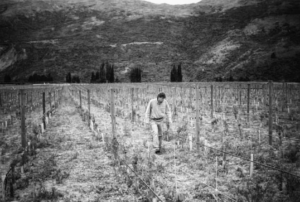
Grant Taylor with some of his early plantings
The second phase in Central Otago is considered to be the mid-90s through to 2005. This also happens to be when most vines in Central Otago were planted.
Modern winemaking technology, consultant winemakers and heavier wallets meant this wave of producers had an even bigger impact on the international stage. Wine production increased more than tenfold within a decade.
Since then, there’s been a bit of slowdown in Central Otago, although today we are in what is considered the third phase. It is slower, more sustainable and perhaps wiser.
Today most new investments in the Central Otago wine region are by producers that are already based there and have some knowledge of the terrain – its limits and its triumphs. The focus is not on expansion but on improving quality.
Today Central Otago represents just over 5% of New Zealand’s annual production.
Production area of the Central Otago wine region
As of 2018, there are over 1,900 hectares planted (compared to less than 100 in 1996, just over 1,000 in 2004).
Number of producers in Central Otago
136 wine producers in Central Otago
Number of growers in Central Otago
33 grape growers in Central Otago
The Essentials of Terroir: Central Otago wine region guide
Climate & Landscape in the Central Otago wine region

Winter in Central Otago (80Harvests)
There are few wine regions in New Zealand, and perhaps the world, quite as striking as Central Otago. Snowcapped mountains can be found almost 360° around you and there are rushing rivers and canyons aplenty. It’s a dramatic landscape, wild and untamed, apart from the neat rows planted in vineyards and orchards. No surprise then than Central Otago was one of the key destinations where Lord of the Rings was filmed.
The dramatic landscape and mountain chains surrounding the Central Otago wine region also lend themselves to great grape growing. Central Otago has the closest to a continental climate that can be found in New Zealand’s islands. It is protected from any maritime influence by the surrounding mountain chains, which create a rain shadow and prevent any wet and humid fronts coming in. This rain shadow, in fact, makes it the driest of all the wine regions in New Zealand – a major plus for healthy grape growing.
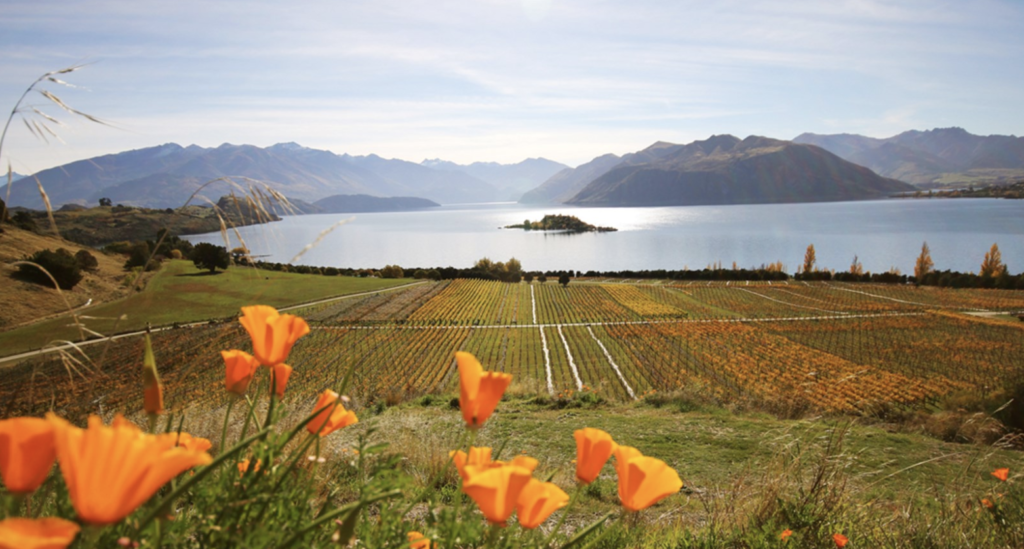
Central Otago in the summer (NZwine.com)
It is also a very sunny climate in the summer. The dry weather means there’s little cloud cover and, at this southerly latitude, the summer has long days with many hours of sunlight. In the summer it can still be light at 10pm. There are high levels of UV in Central Otago and the grape skins are thicker in response. Because of this, the Pinot Noir from Central Otago tends to have a much deeper and darker colour than usual.
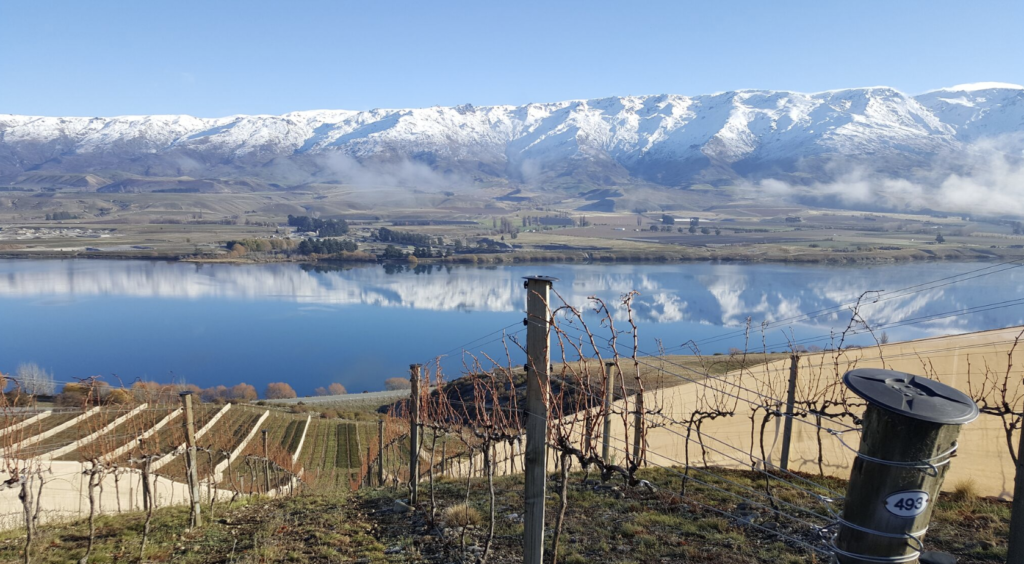
Rocky Point vineyard in Bendigo at Prophet’s Rock after harvest (Paul Pujol)
During the winter Central Otago is cold and snowy, while summer is hot and dry. In the summer, the diurnal range is also pretty extreme – day time temperatures in the summer can reach up to 30°C while in the evening they can dip into single digits. These extreme contrasts, unfortunately, also mean that Central Otago is one of the more frost-prone wine regions. Anti-frost wind machines and sprinklers are found in almost every vineyard.
Fast Facts: Central Otago wine region guide
Temperature in Central Otago
Average temperature in Bannockburn in January (peak of summer) 18°C, and the average in July (peak of winter) is 4°C. Daytime temperatures in the summer can range between 30°C during the day and down to 8°C at night.
Rainfall in Central Otago
340-600mm a year (depending on the region). Drip irrigation is essential (at least for establishing the vines) and irrigation water is all from snowmelt from the Southern Alps.
Other Climate Notes
- There can be a strong Nor’westerly wind, which helps keep vines and grapes dry and healthy.
- While the season is relatively short in Central Otago, the long daylight hours in the summer help make up for the shorter ripening time.
Soils in the Central Otago wine region
- Soil profile of the ‘Home Vineyard’ (clay, schist & quartz above a layer of chalk)
- Winemaker Blair Walter explaining pedagogic lime
- Schist soil at Rocky Point
There is a variety of soils in the Central Otago wine region, depending on the sub-region or even the vine location within the same vineyard. Soils are usually well-draining with significant quantities of mica and schist, as well as silty loam. There’s also pedogenic lime here, which is similar to limestone but it is a process that is developed over thousands of years by pressure (rather than marine deposits, which form limestone).
The soils in the hills are much older than those on the valley floor in Central Otago, which has been shaped by glaciations, meaning the valley floor soils tend to be of a light, sandy, gravely-schist base. All of this diversity means that there is quite a palate for vine-growers to play with, including certain manmade soils following gold extraction.
Longitude in Central Otago
169° east
Latitude in Central Otago
45° south
Altitude in Central Otago
In general vineyards in Central Otago are at at an altitude of around 300m. Some creep higher, but the grapes on vines planted at over 400 metres in Central Otago struggle to ripen.
Viticulture Facts & Vineyard Management in Central Otago
Vine training systems & irrigation
Usually VSP with drip irrigation. Irrigation in Central Otago is usually necessary (depending on the sub-region) as most of the rain falls in the winter.
There are many biodynamic and organic producers in Central Otago, estimated at approximately 25%.
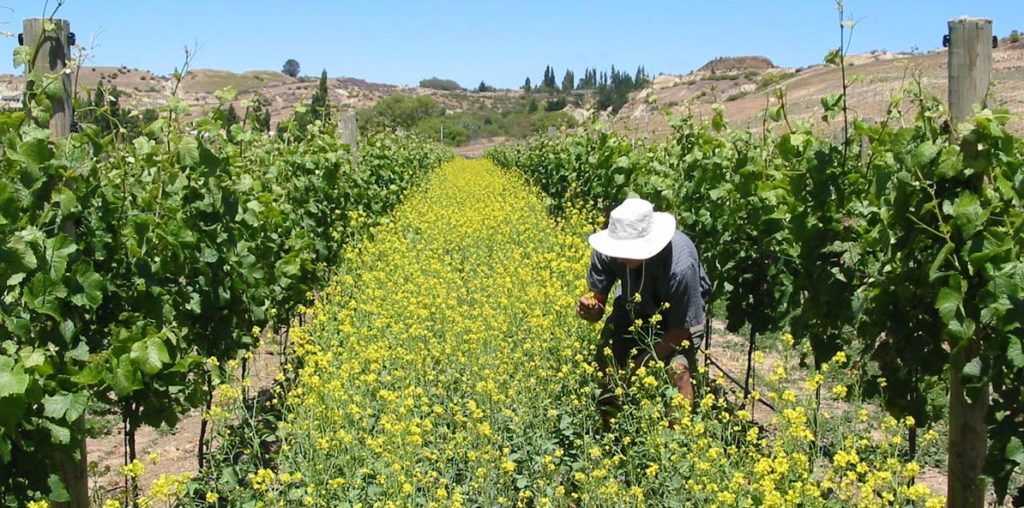
Felton Road’s biodynamic cover crop (FeltonRoad.com)
Harvest Time in Central Otago
Harvest is much later in Central Otago compared to most of New Zealand’s other wine regions, usually starting at the end of March through to late April.
Viticultural challenges in Central Otago
Frost is a major challenge in Central Otago and it can occur before harvest and after the first budbreak, severely damaging yields and the health of the crop. Birds eating the fruit is also a significant concern, as it is elsewhere in New Zealand.
Grape Varieties in Central Otago
Pinot Noir
Pinot Noir accounts for over three quarters of production in Central Otago. There are over 1,500 hectares planted and it is produced in all the sub-regions. The style can vary quite significantly between sub-regions (the cooler and wetter sub-regions like Gibbston and Wanaka produce lighter styles, whereas warm regions like Bannockburn and Bendigo produce bigger, darker styles). In general Pinot Noir from Central Otago has a very deep colour and high acidity.
Chardonnay
There are just 55 hectares of Chardonnay planted in Central Otago (making it the fourth most important grape). However, in my opinion, it is one of the most promising. My favourite Chardonnays from Central Otago were lean, complex and textural, and would certainly age well. (See Felton Road.)
Pinot Gris
The second most planted variety in Central Otago, Pinot Gris accounts for over 210 hectares of plantings. It’s definitely Central Otago’s most famous white grape and deservedly so. In general, winemakers, especially those in the Fine Wines of New Zealand classification, focus on making richer, Alsatian styles of Pinot Gris.
Riesling
The third most planted variety, Riesling, boasts 77 hectares in Central Otago. I think Central Otago Riesling is another really exciting category. These wines often take a more Alsatian style in terms of winemaking (usually with old barrels) and they always have killer acidity, which is eased with a little bit of residual sugar. Great potential.
Sauvignon Blanc
Kiwis just can’t resist planting Sauvignon Blanc, and Central Otago has 42 hectares of it. It errs towards more herbaceous and flinty notes.
Gewürztraminer
Just 13 hectares planted, but an important part of the ‘Aromatics’ spectrum of Central Otago wine.
Sub-regions: the Central Otago wine region guide

Three-quarters of Central Otago’s wine production is within the Central Valley, known as the Cromwell Basin (Bannockburn, Bendigo, Pisa). These regions are all situated around the man-made Lake Dunstan.
Bannockburn
One of the warmest of Central Otago’s wine regions with some sandier soils (which help earlier ripening) and also a mix of schist and clay. In Bannockburn the altitudes of vineyards range from 220m to 370m.
Bendigo
One of the warmest, if not the warmest, sub-region of Central Otago. Bendigo is on the east bank of Lake Dunstan and its north-facing vineyards are ideal for trapping light. The altitude of vineyards ranges from 220m to 350m (some of the higher elevation vineyards use terraces). There are a mixture of soils, including schist, clay and lines of chalk.
Gibbston
Vineyards are planted on the slopes of Kawarau River bank and can reach up to 420m altitude, making Gibbston one of the highest elevation regions and one of the coolest wine regions in Central Otago (moderated by the river influence). It is also one of the wettest sub-regions with approximately 600mm of rain a year (the further east you go, the drier it is).
Wanaka
Similar to Gibbston, the vineyards in Wanaka are planted on the slopes facing Lake Wanaka (which helps moderate temperatures) and the higher elevation (ranging from 290m to 320m) gives cooler temperatures. It is the most northerly sub-region.
Alexandra
Central Otago’s first vineyard was planted here in 1864. Today, however, it is one of the smaller regions. One of the driest regions in Central Otago, in Alexandra summer temperatures can get quite high, although nights are very, very cool. The temperature range gives it the highest frost risk. Soils are mainly schist.
Pisa/Lowburn/Cromwell
On the other side of the lake to Bendigo, this large sub-region is mainly planted on lower vineyard terraces and the valley floor.
Read our series of guides to Central Otago wine:
- The anomaly that is Central Otago
- Prophesying for a lighter Central Otago Pinot: Paul Pujol, Prophet’s Rock
- Trailblazing in Bannockburn: Blair Walter, Felton Road
- Then and now: Grant Taylor, Valli Wines
Find out more about New Zealand’s top wines at the Fine Wines of New Zealand website. You’ll also find useful data and information on NZwine.com.
Did you find this Central Otago wine region guide useful? Please consider becoming a member of 80 Harvests for exclusive content and detailed guides.


